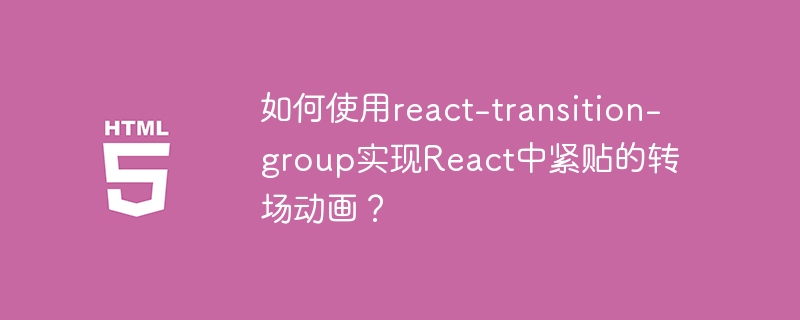 Web Front-end
Web Front-end
 HTML Tutorial
HTML Tutorial
 How to implement a tight transition animation in React using react-transition-group?
How to implement a tight transition animation in React using react-transition-group?
How to implement a tight transition animation in React using react-transition-group?

Use react-transition-group in React to achieve seamless switching animations
In React development, react-transition-group is a common library for implementing animation switching between components. However, in practical applications, developers often encounter situations where the animation effect is not ideal, such as blank areas appearing when component switching, resulting in the animation not being smooth enough. This article analyzes this problem and provides solutions.
Problem Description: The goal is to realize a component switching animation that slides from right to left, requiring the two components to be closely connected during the animation process without any gaps. But the actual effect is that there is blank space between components.
Question code example:
<switchtransition>
<csstransition classnames="checkout" key="{this.state.isPhone}" timeout="{500}">
{this.state.isPhone ? (
<phone handleback="{()"> this.setPhoneState(false)} handlePhoneClick={this.handlePhoneClick} />
) : (
<main handlephoneclick="{this.handlePhoneClick}"></main>
)}
</phone></csstransition>
</switchtransition>Corresponding CSS style:
.checkout-enter {
transform: translateX(100%);
}
.checkout-enter-active {
transform: translateX(0);
transition: all 500ms;
}
.checkout-exit {
transform: translateX(0);
}
.checkout-exit-active {
transform: translateX(-100%);
transition: all 500ms;
}Problem analysis: The above CSS code defines the in-and-out effect of the animation, but does not consider the positional relationship of components during the animation process, resulting in gaps between components.
Solution: The key is to use position: absolute property and precisely control the component's position during the animation process.
Corrected CSS style:
.checkout-enter {
position: absolute;
right: 0;
transform: translateX(100%);
}
.checkout-enter-active {
transform: translateX(0);
transition: all 500ms;
}
.checkout-exit {
position: absolute;
left: 0;
transform: translateX(0);
}
.checkout-exit-active {
transform: translateX(-100%);
transition: all 500ms;
} By setting position: absolute , and positioning the incoming and exiting components to the right and left of the container respectively, ensure that the components are always closely connected during the animation process, thereby eliminating blank areas and seamlessly switching animation effects. This makes the animation smoother and the user experience better.
The above is the detailed content of How to implement a tight transition animation in React using react-transition-group?. For more information, please follow other related articles on the PHP Chinese website!

Hot AI Tools

Undresser.AI Undress
AI-powered app for creating realistic nude photos

AI Clothes Remover
Online AI tool for removing clothes from photos.

Undress AI Tool
Undress images for free

Clothoff.io
AI clothes remover

Video Face Swap
Swap faces in any video effortlessly with our completely free AI face swap tool!

Hot Article

Hot Tools

Notepad++7.3.1
Easy-to-use and free code editor

SublimeText3 Chinese version
Chinese version, very easy to use

Zend Studio 13.0.1
Powerful PHP integrated development environment

Dreamweaver CS6
Visual web development tools

SublimeText3 Mac version
God-level code editing software (SublimeText3)

Hot Topics
 How to use bootstrap in vue
Apr 07, 2025 pm 11:33 PM
How to use bootstrap in vue
Apr 07, 2025 pm 11:33 PM
Using Bootstrap in Vue.js is divided into five steps: Install Bootstrap. Import Bootstrap in main.js. Use the Bootstrap component directly in the template. Optional: Custom style. Optional: Use plug-ins.
 The Roles of HTML, CSS, and JavaScript: Core Responsibilities
Apr 08, 2025 pm 07:05 PM
The Roles of HTML, CSS, and JavaScript: Core Responsibilities
Apr 08, 2025 pm 07:05 PM
HTML defines the web structure, CSS is responsible for style and layout, and JavaScript gives dynamic interaction. The three perform their duties in web development and jointly build a colorful website.
 Understanding HTML, CSS, and JavaScript: A Beginner's Guide
Apr 12, 2025 am 12:02 AM
Understanding HTML, CSS, and JavaScript: A Beginner's Guide
Apr 12, 2025 am 12:02 AM
WebdevelopmentreliesonHTML,CSS,andJavaScript:1)HTMLstructurescontent,2)CSSstylesit,and3)JavaScriptaddsinteractivity,formingthebasisofmodernwebexperiences.
 How to write split lines on bootstrap
Apr 07, 2025 pm 03:12 PM
How to write split lines on bootstrap
Apr 07, 2025 pm 03:12 PM
There are two ways to create a Bootstrap split line: using the tag, which creates a horizontal split line. Use the CSS border property to create custom style split lines.
 How to set up the framework for bootstrap
Apr 07, 2025 pm 03:27 PM
How to set up the framework for bootstrap
Apr 07, 2025 pm 03:27 PM
To set up the Bootstrap framework, you need to follow these steps: 1. Reference the Bootstrap file via CDN; 2. Download and host the file on your own server; 3. Include the Bootstrap file in HTML; 4. Compile Sass/Less as needed; 5. Import a custom file (optional). Once setup is complete, you can use Bootstrap's grid systems, components, and styles to create responsive websites and applications.
 How to insert pictures on bootstrap
Apr 07, 2025 pm 03:30 PM
How to insert pictures on bootstrap
Apr 07, 2025 pm 03:30 PM
There are several ways to insert images in Bootstrap: insert images directly, using the HTML img tag. With the Bootstrap image component, you can provide responsive images and more styles. Set the image size, use the img-fluid class to make the image adaptable. Set the border, using the img-bordered class. Set the rounded corners and use the img-rounded class. Set the shadow, use the shadow class. Resize and position the image, using CSS style. Using the background image, use the background-image CSS property.
 How to use bootstrap button
Apr 07, 2025 pm 03:09 PM
How to use bootstrap button
Apr 07, 2025 pm 03:09 PM
How to use the Bootstrap button? Introduce Bootstrap CSS to create button elements and add Bootstrap button class to add button text
 How to resize bootstrap
Apr 07, 2025 pm 03:18 PM
How to resize bootstrap
Apr 07, 2025 pm 03:18 PM
To adjust the size of elements in Bootstrap, you can use the dimension class, which includes: adjusting width: .col-, .w-, .mw-adjust height: .h-, .min-h-, .max-h-





